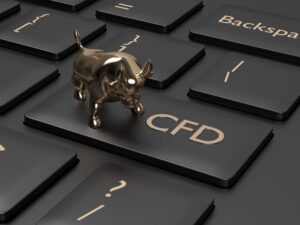
Financial trading encompasses a wide array of investment opportunities. Contracts for Difference (CFDs) and traditional stock trading are two major options. Each provides a potential for substantial returns, yet they come with distinct risk profiles, require varying degrees of involvement, and are suited to different investment approaches. This guide will highlight the essential characteristics of CFDs and stocks to aid you in determining the option that aligns with your trading style.
Understanding CFDs And Stocks
Before delving into the differences between the two, it’s important to establish what they are.
Stocks, or shares, symbolize ownership in a company. Purchasing a stock means buying a part of that company, entitling you to a share of the company’s profits and voting rights in shareholder meetings.
Contrarily, CFDs, short for Contracts for Difference, are derivative products. Instead of owning the underlying asset (here, a stock), you enter into a contract with the broker, speculating on the asset’s price movement. While you won’t receive dividends or voting rights, correctly predicting the asset’s price movement allows for monetary gains.
Distinguishing Between CFDs And Stocks
- Ownership
In stock trading, buying a share means purchasing a stake in the company. This entitles you to a portion of its profits (dividends) and a voice in the company’s governance (voting rights). You can hold these shares as long as you wish, potentially benefiting from the company’s long-term growth.
On the other hand, trading CFDs doesn’t grant you any ownership. Instead, you enter a contract to exchange the difference in the price of an asset from when the contract is opened to when it is closed. You’re essentially betting on price movements without owning the asset itself. This difference is fundamental because it impacts the rights and responsibilities you have in each case and the potential returns you can expect.
- Leverage
CFD trading allows for leverage, which means you can open a position much larger than the amount of capital you put down initially. The broker essentially loans you the money to take a larger position. This means potential profits, and losses, are magnified. For example, if you use 10:1 leverage, a 1% price movement in your favor would lead to a 10% profit. However, a 1% movement against you would lead to a 10% loss.
Conversely, traditional stock trading typically doesn’t involve leverage. When you buy a stock, you pay the full price upfront. This means that while your potential profits might be lower, your losses are capped at the amount you’ve invested.
- Short Selling
CFD trading provides an easy way to profit from falling prices by taking a ‘short’ position. If you believe an asset’s price will fall, you can sell a CFD on that asset with the intention of buying it back later at a lower price, thus making a profit.
In contrast, short selling in stock trading involves a more complex process: you borrow shares from a broker to sell them, hoping to buy them back later at a lower price. However, borrowing these shares can incur costs, and you’re obliged to return the shares eventually, which can create additional risks.
- Trading Costs
Every trading method involves certain costs. With CFDs, these are usually embedded in the spread, which is the difference between the buying price (bid) and selling price (ask). You might also face overnight financing costs if you keep a position open beyond a certain time in the day, which covers the cost of the leverage your broker provided.
In stock trading, costs are often clearer—you usually pay a commission on each transaction. However, these can add up, especially if you trade frequently.
- Dividends And Corporate Actions
Owning stocks gives you a right to a share of the company’s profits, usually paid as dividends, and the ability to participate in corporate actions. These can include voting on company matters (like electing board members), stock splits (where each stock is divided to create more shares), or mergers and acquisitions (where companies combine or are bought out).
CFD traders don’t have these rights or opportunities. Their relationship is with the broker, not the company itself. So while they can profit from price movements related to such events, they don’t participate directly.
Is CFD Trading For You?
Consider CFD trading if:
- You can handle higher risk in pursuit of greater returns, referring to the leverage CFD trading offers. Remember, leverage enhances not only potential profits but also potential losses.
- Your trading perspective is short-term. CFDs, not involving ownership, are well-suited for trades lasting less than a day, like intraday trading, where positions open and close within a single trading day. CFD trading fits active traders who continually respond to market trends.
- You desire to benefit from both rising and falling markets. With CFD trading, you can profit from both upward and downward price movements.
- Lack of ownership of the underlying asset is not an issue. CFD trading doesn’t grant you voting rights or eligibility for dividends. If you’re primarily interested in speculating on price movements, CFD trading could be suitable.

Is Stock Trading Your Preferred Style?
Stock trading might suit you if:
- You value owning the underlying asset and having a stake in the company. Purchasing stocks grants you ownership in a company, making you a part-owner.
- You are in for the long haul, seeking potentially slower, steadier returns. Stocks are typically a long-term investment that can provide significant returns over time, though they don’t offer the rapid, substantial profits that CFDs can.
- You aim to receive dividends and participate in corporate actions, advantages not provided by CFD trading.
- The prospect of losing more than your initial investment is a deterrent. In stock trading, losses are limited to the amount of money invested, unlike in leveraged CFD trading.
Concluding Thoughts
No universal answer exists as to whether CFDs or stocks are the superior options. Each has its benefits and drawbacks, and understanding these is key to aligning with your trading objectives. Always remember that investing invariably involves risk, and managing this risk effectively is essential, irrespective of the financial instrument you opt for.


































